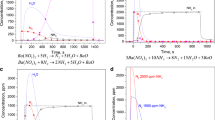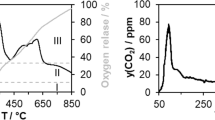Abstract
The structure–reactivity relationships of model BaO-based NOx storage/reduction catalysts were investigated under well controlled experimental conditions using surface science analysis techniques. The reactivity of BaO toward NO2, CO2, and H2O was studied as a function of BaO layer thickness [0 < θBaO < 30 monolayer (ML)], sample temperature, reactant partial pressure, and the nature of the substrate the NOx storage material was deposited onto. Most of the efforts focused on understanding the mechanism of NO2 storage either on pure BaO, or on BaO exposed to CO2 or H2O prior to NO2 exposure. The interaction of NO2 with a pure BaO film results in the initial formation of nitrite/nitrate ion pairs by a cooperative adsorption mechanism predicted by prior theoretical calculations. The nitrites are then further oxidized to nitrates to produce a fully nitrated surface. The mechanism of NO2 uptake on thin BaO films (<4 ML), BaO clusters (<1 ML) and mixed BaO/Al2O3 layers are fundamentally different: in these systems initially nitrites are formed only, and then converted to nitrates at longer NO2 exposure times. These results clarify the contradicting mechanisms presented in prior studies in the literature. After the formation of a nitrate layer the further conversion of the underlying BaO is slow, and strongly depends on both the sample temperature and the NO2 partial pressure. At 300 K sample temperature amorphous Ba(NO3)2 forms that then can be converted to crystalline nitrates at elevated temperatures. The reaction between BaO and H2O is facile, a series of Ba(OH)2 phases form under the temperature and H2O partial pressure regimes studied. Both amorphous and crystalline Ba(OH)2 phases react with NO2, and initially form nitrites only that can be converted to nitrates. The NO2 adsorption capacities of BaO and Ba(OH)2 are identical, i.e., both of these phases can completely be converted to Ba(NO3)2. In contrast, the interaction of CO2 with pure BaO results in the formation of a BaCO3 layer that prevents to complete carbonation of the entire BaO film under the experimental conditions applied in these studies. However, these “carbonated” BaO layers readily react with NO2, and at elevated sample temperature even the carbonate layer is converted to nitrates. The importance of the metal oxide/metal interface in the chemistry on NOx storage-reduction catalysts was studied on BaO(<1 ML)/Pt(111) reverse model catalysts. In comparison to the clean Pt(111), new oxygen adsorption phases were identified on the BaO/Pt(111) surface that can be associated with oxygen atoms strongly adsorbed on Pt atoms at the peripheries of BaO particles. A simple kinetic model developed helped explain the observed thermal desorption results. The role of the oxide/metal interface in the reduction of Ba(NO3)2 was also substantiated in experiments where Ba(NO3)2/O/Pt(111) samples were exposed to CO at elevated sample temperature. The catalytic decomposition of the nitrate phase occurred as soon as metal sites opened up by the removal of interfacial oxygen via CO oxidation from the O/Pt(111) surface. The temperature for catalytic nitrate reduction was found to be significantly lower than the onset temperature of thermal nitrate decomposition.






















Similar content being viewed by others
References
Granger P, Parvulescu VI (2011) Chem Rev 111:3155
Matsumoto S (2000) CATTECH 4:102
Shelef M (1995) Chem Rev 95:209 (and references therein)
Hoard J, Panov A, SAE Technical Paper 2001-01-3512
Tonkyn RG, Yoon S, Barlow SE, Panov A, Kolwaite A, Barmer ML (2000) SAE 1:2869
Takahashi N, Shinjoh H, Iijima T, Suzuki T, Yamazaki K, Yokota K, Suzuki H, Miyoshi N, Matsumoto S, Tanizawa T, Tanaka T, Tateishi S, Kasahara K (1996) Catal Today 27:63
Epling WS, Parks JE, Campbell GC, Yezerets A, Currier NW, Campbell LE (2004) Catal Today 96:21 (and references therein)
Stone P, Ishii M, Bowker M (2003) Surf Sci 537:179
Bowker M, Stone P, Smith R, Fourre E, Ishii M, Leeuw NH (1973) Surf Sci 2006:600
Bowker M, Cristofolini M, Hall M, Fourre E, Grillo F, McCormack E, Stone P, Ishii M (2007) Top Catal 42:341
Bowker M (2008) Chem Soc Rev 37:2204
Mudiyanselage K, Yi CW, Szanyi J (2009) Langmuir 26:10820
Mudiyanselage K, Yi CW, Szanyi J (2010) J Phys Chem C 114:16955
Mudiyanselage K, Mei D, Yi CW, Weaver JF, Szanyi J (2010) J Phys Chem C 114:20195
Mudiyanselage K, Weaver JF, Szanyi J (2011) J Phys Chem C 115:5903
Mudiyanselage K, Yi CW, Szanyi J (2011) Phys Chem Chem Phys 13:11016
Mudiyanselage K, Szanyi J (2012) Catal Today 181:116
Tsami A, Grillo F, Bowker M, Nix RM (2006) Surf Sci 600:3403
Schmitz P, Baird RJ (2002) J Phys Chem B 106:4172
Ozensoy E, Szanyi J, Peden CHF (2005) J Phys Chem B 109:3431
Ozensoy E, Peden CHF, Szanyi J (2005) J Phys Chem B 109:15977
Ozensoy E, Peden CHF, Szanyi J (2006) J Phys Chem B 110:17001
Ozensoy E, Peden CHF, Szanyi J (2006) J Phys Chem B 110:17009
Ozensoy E, Peden CHF, Szanyi J (2006) J Catal 243:149
Desikusumastuti A, Laurin M, Happel M, Qin Z, Shaikhutdinov S, Libuda J (2008) Catal Lett 121:311
Desikusumastuti A, Staudt T, Grönbeck H, Libuda J (2008) J Catal 255:127
Desikusumastuti A, Happel M, Dumbuya K, Staudt T, Laurin M, Gottfried JM, Steinruck HP, Libuda J (2008) J Phys Chem C 112:6477
Staudt T, Desikusumastuti A, Happel M, Vesselli E, Baraldi A, Gardonio S, Lizzit S, Rohr F, Libuda J (2008) J Phys Chem C 112:9835
Vines F, Desikusumastuti A, Staudt T, Gorling A, Libuda J, Neyman KM (2008) J Phys Chem C 112:16539
Desikusumastuti A, Staudt T, Happel M, Laurin M, Libuda J (2008) J Catal 260:315
Desikusumastuti A, Qin Z, Staudt T, Happel M, Lykhach Y, Laurin M, Shaikhutdinov S, Libuda J (2009) Surf Sci 603:9
Desikusumastuti A, Schernich S, Happel M, Sobota M, Laurin M, Libuda J (2009) ChemCatChem 1:318
Desikusumastuti A, Staudt T, Qin Z, Happel M, Laurin M, Lykhach Y, Shakhutdinov S, Rohr F, Libuda J (2009) Chemphyschem 9:2191
Yi CW, Kwak JH, Peden CHF, Wang C, Szanyi J (2007) J Phys Chem C 111:14942
Yi CW, Kwak JH, Szanyi J (2007) J Phys Chem C 111:15299
Kwak JH, Mei D, Yi CW, Peden CHF, Szanyi J (2009) J Catal 261:17
Yi CW, Szanyi J (2009) J Phys Chem C 113:716
Yi CW, Szanyi J (2009) J Phys Chem C 113:2134
Yi CW, Szanyi J (2009) J Phys Chem C 113:15692
Desikusumastuti A, Qin Z, Happel M, Staudt T, Lykhach Y, Laurin M, Rohr F, Shaikhutdinov S, Libuda J (2009) Phys Chem Chem Phys 11:2514
Schneider WF (2004) J Phys Chem B 108:273
Schneider WF, Hass KC, Miletic M, Gland JL (2002) J Phys Chem B 106:7405
Broqvist P, Grönbeck H, Fridell E, Panas I (2004) Catal Today 96:71
Broqvist P, Panas I, Gronbeck H (2005) J Phys Chem B 109:15410
Szanyi J, Kwak JH, Kim DH, Wang X, Chimentao R, Hanson J, Epling WS, Peden CHF (2007) J Phys Chem C 111:4678
Lutz HD, Eckers W, Schneider G, Haeuseler H (1981) Spectrochim Acta A 37:561
Maneva-Petrova M, Nikolova D (1985) Thermochim Acta 92:287
Cordfunke EHP, Booij AS, Konings RJM, van der Laan RR, Smit Green VM, van Vlaanderen P (1996) Thermochim Acta 273:1
Friedrich A, Kunz M, Suard E (1996) Acta Crystallogr A 57:747
Gland JL (1980) Surf Sci 93:487
Gland JL, Sexton BA (1980) Surf Sci 94:355
Materer N, Starke U, Barbieri A, Doll R, Heinz K, Van Hove MA, Somorjai GA (1995) Surf Sci 325:207
Steininger H, Lehwald S, Ibach H (1982) Surf Sci 123:1
Weaver JF, Chen J, Gerrard AL (2005) Surf Sci 592:83
Gerrard AL, Weaver JF (2005) J Chem Phys 123:224703
James D, Fourre E, Ishii M, Bowker M (2003) Appl Catal B 45:147
Acknowledgments
The authors are thankful for the initial work on model NOx storage system by Prof. Emrah Ozensoy, and the helpful discussions with Dr. Charles H.F. Peden. We gratefully acknowledge the UD Department of Energy (DOE), Office of Science, Division of Chemical Sciences for the support of this work. The research described in this paper was performed at the Environmental Molecular Sciences Laboratory (EMSL), a national user facility sponsored by the DOE Office of Biological and Environmental Research and located at the Pacific Northwest National Laboratory (PNNL). PNNL is operated for the US DOE by Battelle Memorial Institute under contract number DE-AC05-76RL01830. The authors acknowledge the many contributions of Prof. D.W. Goodman to the field of surface science in automotive catalysis. His fundamental studies on CO oxidation and CO + NO reactions on noble metal surfaces formed the foundation of our understanding of three-way catalysis. Some of us (J.Sz. and CW.Y.) were fortunate enough to be mentored by Wayne, and his contagious enthusiasm with which he approached the everyday challenges of life in a surface science lab will always stay with us. His scientific insights and intuitions, guidance, enthusiasm, friendship and wonderful humor are greatly missed.
Author information
Authors and Affiliations
Corresponding author
Rights and permissions
About this article
Cite this article
Szanyi, J., Yi, C.W., Mudiyanselage, K. et al. Understanding Automotive Exhaust Catalysts Using a Surface Science Approach: Model NOx Storage Materials. Top Catal 56, 1420–1440 (2013). https://doi.org/10.1007/s11244-013-0152-9
Published:
Issue Date:
DOI: https://doi.org/10.1007/s11244-013-0152-9




